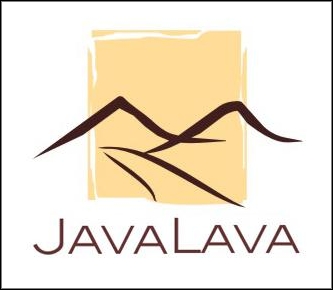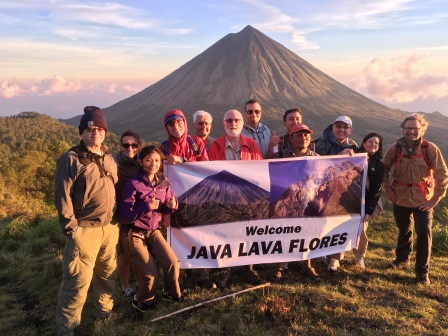Java Lava dates back to the early 1980s when several expats, mainly in the oil industry, began to organise some climbs. An early enthusiast was Andy Wight who, in May 1981 went by train to Yogyakarta to climb Gunung Merapi with a group of friends, including some ‘middle-aged, unfit, beer-drinking debauchees’*. It was on this trip that Andy coined the name ‘Java Lava’ and proposed the first rule of association, that there should be ‘no rules’ (other than safety on mountains – ed).
Rob Valkhoff was also arranging climbs around this time. Andy and Rob met, perhaps in 1986 on a Gunung Semeru climb, and teamed up. Very little information was available in those early days about routes up mountains. Rob (Netherlander) had a classic book,”Gids voor bergtochten op Java“, by Dr Ch. E. Stehn, Uitgegeven Door de Nederlandsch-Indische Vereeniging voor Bergsport, 1930. Stehn had carefully recorded tracks, elevations, walking times, topographic information, etc. that were still valid in many cases. The early years of Java Lava involved collecting information about mountains but, once a mountain had been climbed, trips were much easier.
Climbs were spasmodic in the early 1980s. There was no email and even fax was unreliable so trips were organised mainly by phone calls. Travel by plane and minibus was usually not a problem. Accommodation was often basic.
Two trips in the early 1980s illustrate early attempts to climb a mountain then unknown to us. Gunung Tambora, Sumbawa, that erupted in 1815, the ‘biggest volcanic explosion in recorded history’, presented such a challenge. The first attempt in 1983 ended in failure as the local police demanded that we produce a surat jalan, an authorisation from the police in Jakarta to travel to Sumbawa, and sent us packing home. The second, in 1985, failed because our so-called guides lost their way cutting a track through the forest.
Java Lava has successfully climbed Tambora several times since, including in April 2015 to commemorate 200 years since its massive eruption of April 1815. In the early 1980s, Tambora’s slopes were covered with pristine forest that had regrown since the devastating eruption of 1815. But since then, commercial companies have clear-felled the forests, which are only now regenerating. On 12 April 2015, the bicentenary of the eruption, the President of Indonesia declared Tambora a National Park.
In 1984, Rob Valkhoff began to organize more regular trips. In those days, they usually did about eight trips each year. Rob would choose a destination and his secretary would call around about two weeks before to those who might wish to join. Ronnie Hotmaparna, at that time a student and leader of a self-styled Indonesian mountaineering group, was Rob’s mountain scout for many years. Ronnie would check the destination a few days before the climb, organized transport, accommodation, guides and porters. Upon arrival, Ronnie would be waiting and the trip usually preceded like clockwork.
Trips were tough in those days. Even ‘toughies’ like Gunungs Raung and Slamet were climbed in one day. Rob remembers many treks starting long before dawn and returning after dark. Only in the most remote areas and on the longest trips would they camp on the mountain.
Over the years, Java Lava has changed its climbing ways. For the more difficult mountains, we start at sunrise and camp early afternoon near the summit. If lucky, we would see the most amazing sunsets and sunrises from the summit.
From the earliest days, Java Lava took safety-on-mountains seriously. We recall a situation on Gunung Semeru when the eruption cycle was about 15 minutes. During a pause in the eruptions, two Dutchmen defied warnings and went to the crater rim to take pictures of the crater bottom. Sure enough, as soon as they brought their cameras into position, the whole crater exploded. They were lucky to survive with minor burns only. One camera was smashed but the cassette was retrieved and recorded a most extraordinary movie.
Over the years, we have seen a slow degradation of forests on many of the mountains. There is hardly a mountain unaffected. Besides illegal logging, the main cause of deforestation is pressure from local communities to open up new land for agriculture. So the pilfering and degradation of natural forests, even within National Parks, continues unabated. Climbing pressure on the mountains is increasing every year as more and more so-called ‘Friends of Nature’ climb mountains. Rubbish left by these climbers is becoming horrific.
Rob left Indonesia in 1988 and asked Herbert Motz to take over. Rob was adamant that Herbert should bring Java Lava to new heights. Herbert introduced a yearly program with fixed hiking dates and destinations. Jenny, his assistant, before they both retired, continues to arrange Java Lava trips. And later again, when Herbert retired in 2002, he transferred leadership of Java Lava to David Donaldson, a very able successor.
In the eighties, Java Lava had some 30 people on its mailing list almost all expatriates in Indonesia. Few locals joined at that time but this has changed over the years. We now have Indonesians, Singaporeans and Malaysians on our climbs reflecting an increasing regional interest in the mountains of Indonesia. Women are increasingly joining Java Lava trips. With the introduction of the Java Lava website in 2006, the mailing list has grown to some 420 subscribers.
Herbert recalls that, amongst the many trips that he and Jenny have arranged, they have met many people of different nationalities and cultures. All are different characters in their own right but rarely does somebody not fit into the group. The common experience of climbing a mountain is a strong bond fostering wonderful friendships.
In 2015, the ‘old hands’, passed the Java Lava ‘hiking boots’ to a younger generation of regular, experienced Java Lava climbers. Java Lava has now firmly established the tradition of enabling like-minded enthusiasts to enjoy nature, mountains and adventure.
Sadly, Rob Valkhoff passed away on 9 June 2018 at the age of 88.
* Jakarta Highland Gathering Magazine, 1983, Andy Wight, Ring of Fire, p 23.


